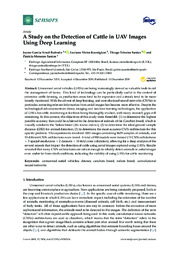A study on the detection of cattle in UAV images using deep learning.
A study on the detection of cattle in UAV images using deep learning.
Author(s): BARBEDO, J. G. A.; KOENIGKAN, L. V.; SANTOS, T. T.; SANTOS, P. M.
Summary: Abstract: Unmanned aerial vehicles (UAVs) are being increasingly viewed as valuable tools to aid the management of farms. This kind of technology can be particularly useful in the context of extensive cattle farming, as production areas tend to be expansive and animals tend to be more loosely monitored. With the advent of deep learning, and convolutional neural networks (CNNs) in particular, extracting relevant information from aerial images has become more effective. Despite the technological advancements in drone, imaging and machine learning technologies, the application of UAVs for cattle monitoring is far from being thoroughly studied, with many research gaps still remaining. In this context, the objectives of this study were threefold: (1) to determine the highest possible accuracy that could be achieved in the detection of animals of the Canchim breed, which is visually similar to the Nelore breed (Bos taurus indicus); (2) to determine the ideal ground sample distance (GSD) for animal detection; (3) to determine the most accurate CNN architecture for this specific problem. The experiments involved 1853 images containing 8629 samples of animals, and 15 different CNN architectures were tested. A total of 900 models were trained (15 CNN architectures 3 spacial resolutions 2 datasets 10-fold cross validation), allowing for a deep analysis of the several aspects that impact the detection of cattle using aerial images captured using UAVs. Results revealed that many CNN architectures are robust enough to reliably detect animals in aerial images even under far from ideal conditions, indicating the viability of using UAVs for cattle monitoring.
Publication year: 2019
Types of publication: Journal article
Related content
Observation
Some of Embrapa's publications are published as ePub files. To read them, use or download one of the following free software options to your computer or mobile device. Android: Google Play Books; IOS: iBooks; Windows and Linux: Calibre.
Access other publications
Access the Agricultural Research Database (BDPA) to consult Embrapa's full library collection and records.
Visit Embrapa Bookstore to purchase books and other publications sold by Embrapa.

